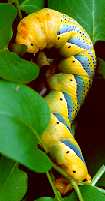Cheshire
Macro-Moths - Death's-head Hawk-moth
 The
Death's-head Hawk-moth - Acherontia atropos Linnaeus
The
Death's-head Hawk-moth - Acherontia atropos Linnaeus
Imago / Adult:
The large adult moth (imago) varies between 100 and
135 millimetres in wingspan. The ground colour of the forewings is
a deep velvety black whilst the hind wings are a vivid orange-yellow.
The English name of the moth is derived from the markings on the back
of the thorax which resemble, broadly, a skull although there is some
evidence that under UV light this more closely resembles the head
of a queen honey bee. The moth is a regular immigrant which used to
be moderately common in the county of Cheshire about 100 years ago,
the larvae and especially the pupae being found in potato fields by
the potato pickers at harvest time. Unfortunately, with the advent
of poisonous sprays to combat insect 'pests' on crops this is now
a rare event. May to September are the usual months when the moths
appear in this country and it is most commonly found along the southern
coastal counties although it has turned up over most of Britain.
Larva:
The large larvae, usually 100 to 125mm in length, are
of the normal hawk-moth larval format being large and fat but instead
of having the normal hawk-moth larval spike/point/horn/tail at the
rear of the body, they have a small yellow or brown lumpy growth.
The ground colour of the larva is usually a bright yellow though variants
of a yellowish-green, or even a darkish brown do occur. The body of
the larva has oblique purplish-grey stripes on the sides and also
has spots on the upper surface towards the head-end of the same colour.
The spiracles are large and a dark purplish-black in colour.
Foodplant(s):
The foodplants consist of many species of Solanum,
especially Potato. In captivity it has been successfully reared through
to the adult on Privet (Wild and Garden varieties), on Ash and on
Lilac.
Overwintering:
The moth does not overwinter in Britain. Our winter
climate of cold, and especially damp, kills off any late developing
larvae and pupae.